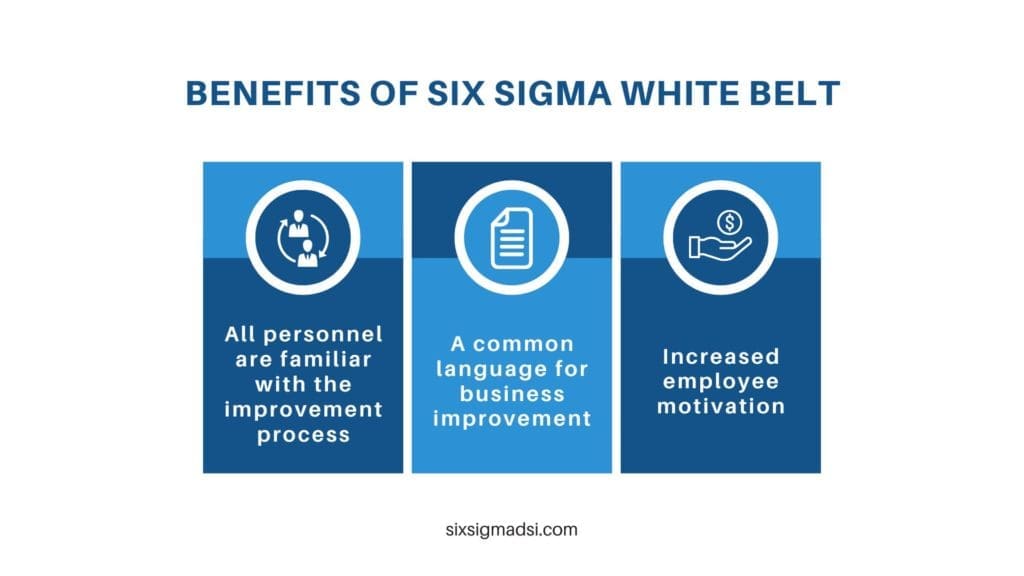Table of contents
The Lean Six Sigma White Belt certified people provide information about the basic concepts of Lean Six Sigma. Lean Six Sigma White Belts Certification is able to help with organizational change management and can join local problem-solving clubs that support projects. Professionals can also earn Six Sigma Green and Black Belt certificates, which can lead them to higher ranks and better jobs because having a six sigma white belt certification is a great credential in your resume.
You may feel the need to make a change in your career at some point. You can make a positive change to help you reach your career goals. It all depends on how you move. You will need to prove that you are ready to face the challenges, regardless of whether you want to change employers or climb the corporate ladder. You can expand your career options by enrolling in Six Sigma White Belt Training. White Belt training is the first step in the Six Sigma journey. It’s ideal for people who don’t have any prior knowledge and are open to change. These are the top ten reasons to enroll in our Six Sigma White Belt Training Course.
Structure of Six Sigma Certifications
The Lean Six Sigma belt system is similar to martial art. The belt system allows Lean Six Sigma project groups to work together. It helps team members to understand their roles and what they can expect from a project.
Based on their certification and training, employees are assigned different belt levels. This allows them to take on different roles in the development of the project. These are the most popular belt levels:
- Six Sigma White Belt – This local team supports Six Sigma projects. This team has a basic but solid understanding of Six Sigma.
- Lean Six Sigma Yellow Belt Participates in the team to discuss the process and any improvements that would support this project.
- Six Sigma Green Belt Contributes to the team, by collecting and analyzing data.
- Six Sigma Black Belt Leads Six Sigma projects, and trains and coaches project team members.
- Lean Six Sigma Master Black Belt Coaches Black Belts as much as Green Belts. These metrics are used to determine strategic direction.

The Lean Six Sigma White Belt: What is it?
All belt ranks play a supporting role in Lean Six Sigma projects, helping them improve their quality. The White Belt is crucial to Lean Six Sigma for two reasons:
First, they provide valuable support. Experienced white belts can be a valuable resource in helping to collect data and providing expert insight into the workings.
Second, all future Lean Six Sigma practitioners begin at the White Belt Level. This program can help introduce Lean Six Sigma to the most talented employees in the company. This could result in a lasting relationship between the employee and the company.
Employees who have demonstrated enthusiasm for Lean Six Sigma and are white belts can be made yellow and green belts. If they choose, they can attain higher belt ranks or more expertise.
Because of its supporting role, all belt ranks help Six Sigma projects improve their quality. Two reasons the White Belt is essential to Six Sigma are: The first is the invaluable support they offer. White belts with experience can be a great resource for helping to gather data and provide expert insight into the workings of processes.
Second, all future Six Sigma practitioners start at the White Belt level. The White Belt training program could help to introduce the organization’s most promising employees to Six Sigma. This could lead to a long-lasting relationship between the company and the employee.
Employees who are white belts and show enthusiasm for Six Sigma can become Yellow Belts and Green Belts. They can then achieve higher belt ranks and more expertise if they so choose.
Potential candidates for the Lean Six Sigma White Belt
Lean Six Sigma white belt certification is available to Lean Six Sigma professionals. This training is ideal for people who are just starting to learn about Lean Six Sigma and want to see the potential benefits to their organization. These candidates are eligible to benefit from the training.
- Managers might be interested in Lean Six Sigma.
- For professionals who want to implement basic LEAN principles within their companies.
- Leaders who understand the importance of quality improvement
- Candidates who are interested in learning more about Lean Six Sigma.
- Employees who are Lean Six Sigma-focused work in an organization.
- Anyone who is interested in learning the best Lean Six Sigma principles and methodologies.
What salary range is expected?
A White belt’s salary range is $40,000-$80,000 USD, depending on where you live.
Benefits of Six Sigma White Belt

- All personnel are familiar with the improvement process
- A common language for business improvement
- All personnel is required to participate in all improvements.
- Ideas and contributions to improving work and processes
- Increased employee motivation
- Minimum one improvement per person and per period
Lean Six Sigma White Belt Course Description
Drexel University’s interactive training uses a set of tools to help you develop a foundation for lean Six Sigma process improvement.
- Get a solid understanding of the importance and implementation of Lean Six Sigma principles
- Discover the strategic questions that will encourage the use of Lean Six Sigma tools to drive business value, lead changes, and ensure return on investment (ROI).
- Get a hands-on view of the DMAIC process improvement methodology
- Learn how to maintain improvements
- Learn how to measure process performance
- Learn how to define the scope and intent of a project
- Improve your customer satisfaction
This course will help you get started in Lean Six Sigma process improvements. It is also great for leaders who want to introduce Lean Six Sigma principles and training to their employees.
In conclusion
Lean Six Sigma White Belt plays an important role in implementing continuous improvement within an organization. They are the subject matters expert (SME). This belt is the first step in introducing an employee to Lean Six Sigma continuous improvements culture.



















